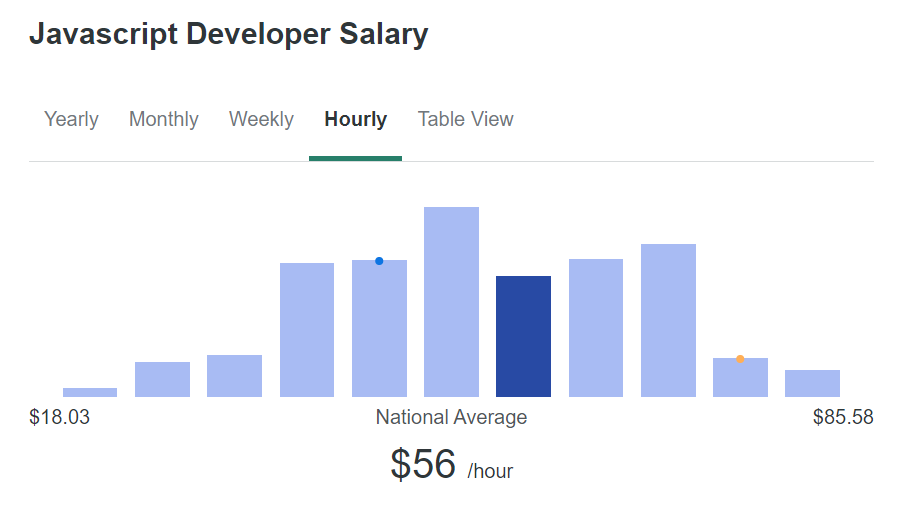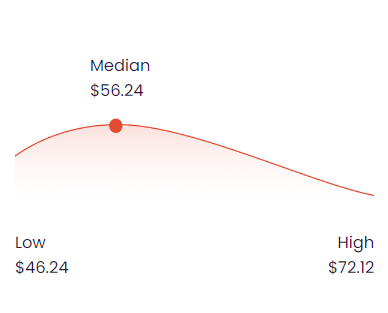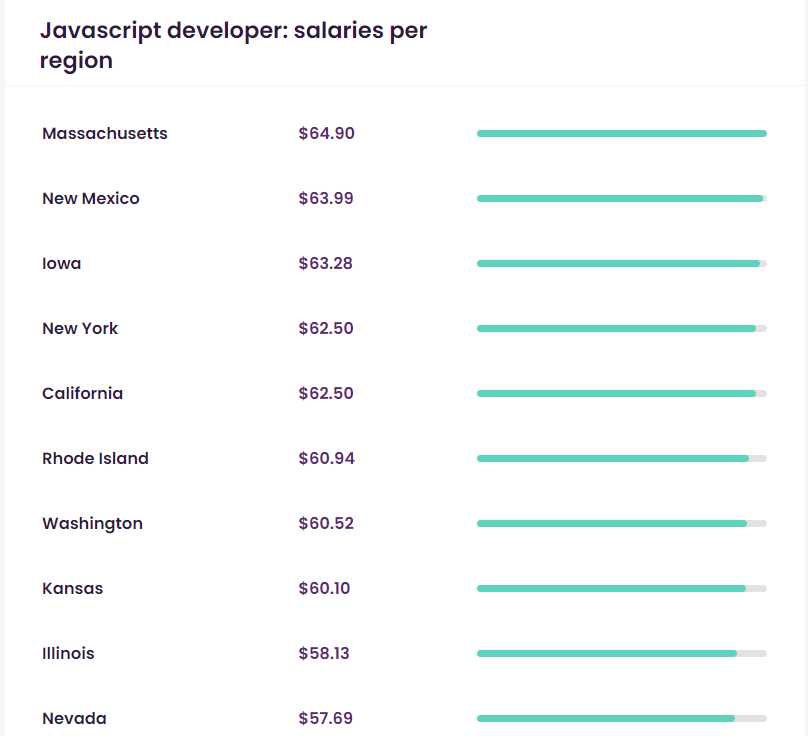The JavaScript Developer Hourly Rate Guide
As of November 10, 2023, the average hourly pay for a Javascript Developer in the United States is $56.13, with rates ranging from $18.03 to $85.58. Most developers earn between $45.19 and $67.31 per hour, indicating potential for career advancement.
Table of Contents
In an ever-evolving world of technology, one thing remains constant: the demand for dedicated JavaScript developers. JavaScript, as the language of the web, remains the go-to technology for dynamic web content and has been steadily growing in popularity. Therefore, businesses looking to hire a JavaScript developer need to stay informed about the current market rates.
Average Hourly rate of JavaScript Developer
According to data provided by ZipRecruiter, the average hourly pay for a JavaScript developer in the United States is $56.13, with the potential to reach as high as $85.58 and as low as $18.03. The majority of JavaScript developer hourly rates currently range between $45.19 (25th percentile) to $67.31 (75th percentile) across the United States. This pay range variance of up to $22.12 indicates plenty of opportunities for hourly rate growth and advancement within the field.
According to ZipRecruiter in the United States, a Javascript Developer earns an average of $56.13 per hour. The salary distribution indicates that the majority earn between $45.19 and $67.31 per hour, representing the 25th and 75th percentiles, respectively.
JavaScript Developer Salaries by Framework Mastery and Experience Level
A developer’s familiarity with different JavaScript frameworks significantly influences their positioning within the job market and hourly rates.
Angular.js – Being a comprehensive framework backed by Google, developers proficient in Angular.js are in high demand for complex, large-scale applications. They may command higher hourly rates due to their specialized skills.
React.js – React.js, supported by Facebook, is very popular for developing dynamic and high-performing user interfaces. JavaScript developers skilled in React.js are highly sought after and may charge competitive rates.
Vue.js – Vue.js is relatively newer, but its simplicity and learning curve make it an attractive option. Developers proficient in Vue.js are growing in number and might have competitive or slightly lower rates, but as demand grows, their rates may rise.
Node.js – Node.js developers work on the server side, a different area compared to the client-facing JavaScript frameworks. Their expertise in backend development may lead them to charge higher rates due to the specialized nature of this work.
React Native – React Native allows developers to write mobile applications in JavaScript, a skill that can command higher rates due to the cross-platform development it enables.
Comparing JavaScript Developer Hourly Rates Across Countries
JavaScript developers based in the United States command the highest rates, reflective of the country’s mature tech industry and high cost of living. Australia also sees fairly high rates, likely due to a similar cost of living and a burgeoning tech scene.
In Europe, the United Kingdom and Germany have relatively high rates, though they are less than those in the United States and Australia. Eastern European countries like Poland and Ukraine offer more competitive rates, demonstrating the growing trend of companies outsourcing to these regions to leverage high-quality work at lower costs.
In Latin America, both Mexico and Brazil display a wide range of rates, indicative of the diversity of the developer pool in these regions.
Asia shows substantial rate variability. Singapore, as an established tech hub, commands higher rates than India and the Philippines, which are known for offering the most affordable rates, likely due to the lower cost of living and a vast supply of developers.
Lastly, South Africa presents lower hourly rates, possibly due to the emerging nature of its tech industry and lower living costs.
| Country | Minimum Hourly Rate | Median Hourly Rate | Maximum Hourly Rate |
|---|---|---|---|
| USA | $51 | $61 | $86 |
| United Kingdom | $22 | $37 | $42 |
| Australia | $37 | $39 | $66 |
| Germany | $25 | $35 | $40 |
| Poland | $20 | $32 | $38 |
| Ukraine | $18 | $20 | $30 |
| Mexico | $19 | $28 | $42 |
| Brazil | $13 | $25 | $40 |
| Singapore | $15 | $19 | $30 |
| India | $8 | $13 | $17 |
| Philippines | $7 | $12 | $15 |
| South Africa | $11 | $23 | $28 |
Statistics from talent.com suggest that even in the United States, the salary obtained by JavaScript developers varies according to the state. The highest salary is obtained by developers in Massachusetts followed by developers in New Mexico, Lowa, New York, California, Rhode Island, Washington, Kansas, Illinois, and Nevada coming in tenth place.
Further, talent.com details that in the United States, the average hourly rate for a JavaScript developer is $56.25 per hour. Entry-level positions start at $46.19 per hour, while the most experienced workers can earn up to $72.12 per hour.
The Impact of Company Size on JavaScript Developers’ Hourly Rates
The data provided by the below chart indicates a trend where the average rates for JavaScript developers increase as the size of the company grows. Smaller companies or startups seem to offer lower rates, potentially reflecting budget limits. As we move up to medium-sized companies, there’s a noticeable rise in rates, which could be due to larger budgets and more complex projects.
This trend continues with large companies and corporations, where the rates increase further, likely reflecting their extensive resources and sophisticated projects. In essence, company size appears to impact the hourly rates for JavaScript developers, with larger companies typically offering higher rates.
JavaScript Developer Hourly Rate Vs Other Programming Languages
Languages such as Clojure, Elixir, Erlang, and F# seem to command higher rates. These languages are often associated with more specialized or niche use cases, and developers skilled in these might be in less supply, leading to higher rates.
On the other hand, languages like Ruby, Scala, Rust, and Go have moderately high rates, potentially reflecting their demand in specific sectors such as web development and systems programming.
Further, languages like Julia, Objective-C, Python, and TypeScript have slightly lower rates, suggesting they have a larger developer base, leading to more competitive rates.
Popular and widely used languages like Swift, C#, SQL, Node.js, JavaScript, and HTML/CSS show lower rates, possibly because of a larger pool of developers which leads to more competitive pricing.
Lastly, PHP seems to have the lowest rate among the provided languages, likely reflecting its widespread use in web development and a substantial base of developers.
This suggests that the rates for developers can significantly vary based on the language specialization, with less common or more niche languages generally commanding higher rates.
Conclusion
It’s important to consider that while cost is a significant factor when you aim to hire a JavaScript developer, it should not be the only one. Always consider the developer’s experience, portfolio, and the complexity of your project. Cheaper isn’t always better, especially when the success of your project is at stake. Hence, finding a skilled and dedicated JavaScript developer who understands your vision and project needs is essential.
This guide provides a general overview of JavaScript developer hourly rates in 2023, but individual rates may vary. Be sure to do your own research and consult with potential experts to find a fit that’s right for you and your project. Hiring a JavaScript developer is an investment in your project’s future, and thus should be approached with care and precision. You can check out our JavaScript Developer Annual Salary Guide to learn about the annual salary rates you can earn in the US and across the world. We bring you a complete JavaScript Developer Hiring Guide along with the JavaScript Developer Job Description and JavaScript Interview Questions guide which will help you in the process of hiring a Shopify developer in 2023.
Table of Contents











